+ Open data
Open data
- Basic information
Basic information
| Entry | Database: PDB / ID: 7f9o | ||||||
|---|---|---|---|---|---|---|---|
| Title | PSI-NDH supercomplex of Barley | ||||||
 Components Components |
| ||||||
 Keywords Keywords | PHOTOSYNTHESIS / Photosystem I / NDH | ||||||
| Function / homology |  Function and homology information Function and homology informationNADH dehydrogenase complex (plastoquinone) assembly / NAD(P)H dehydrogenase complex assembly / NAD(P)H dehydrogenase complex (plastoquinone) / chloroplast stromal thylakoid / protein histidine kinase binding / : / P450-containing electron transport chain / photosynthesis, light harvesting in photosystem I / Translocases; Catalysing the translocation of protons; Linked to oxidoreductase reactions / thylakoid ...NADH dehydrogenase complex (plastoquinone) assembly / NAD(P)H dehydrogenase complex assembly / NAD(P)H dehydrogenase complex (plastoquinone) / chloroplast stromal thylakoid / protein histidine kinase binding / : / P450-containing electron transport chain / photosynthesis, light harvesting in photosystem I / Translocases; Catalysing the translocation of protons; Linked to oxidoreductase reactions / thylakoid / chloroplast thylakoid lumen / photosynthesis, light harvesting / NADH dehydrogenase complex / photosystem II oxygen evolving complex / chloroplast envelope / photosystem I reaction center / photosystem I / photosynthetic electron transport in photosystem I / photosynthetic electron transport chain / photosystem I / oxidoreductase activity, acting on NAD(P)H, quinone or similar compound as acceptor / photosystem II / extrinsic component of membrane / cyclosporin A binding / NADH dehydrogenase activity / chlorophyll binding / chloroplast thylakoid membrane / photosynthesis, light reaction / ubiquinone binding / electron transport coupled proton transport / response to light stimulus / catalytic activity / respiratory chain complex I / NADH dehydrogenase (ubiquinone) activity / defense response to fungus / quinone binding / ATP synthesis coupled electron transport / photosynthesis / aerobic respiration / chloroplast / peptidylprolyl isomerase / peptidyl-prolyl cis-trans isomerase activity / mitochondrial membrane / 2 iron, 2 sulfur cluster binding / NAD binding / protein folding / 4 iron, 4 sulfur cluster binding / carbohydrate binding / response to oxidative stress / carbohydrate metabolic process / electron transfer activity / oxidoreductase activity / iron ion binding / calcium ion binding / magnesium ion binding / metal ion binding / membrane / cytoplasm Similarity search - Function | ||||||
| Biological species |  | ||||||
| Method | ELECTRON MICROSCOPY / single particle reconstruction / cryo EM / Resolution: 4.5 Å | ||||||
 Authors Authors | Wang, W.D. / Shen, L. / Tang, K. / Han, G.Y. / Shen, J.R. / Zhang, X. | ||||||
| Funding support |  China, 1items China, 1items
| ||||||
 Citation Citation |  Journal: Nature / Year: 2022 Journal: Nature / Year: 2022Title: Architecture of the chloroplast PSI-NDH supercomplex in Hordeum vulgare. Authors: Liangliang Shen / Kailu Tang / Wenda Wang / Chen Wang / Hangjun Wu / Zhiyuan Mao / Shaoya An / Shenghai Chang / Tingyun Kuang / Jian-Ren Shen / Guangye Han / Xing Zhang /   Abstract: The chloroplast NADH dehydrogenase-like (NDH) complex is composed of at least 29 subunits and has an important role in mediating photosystem I (PSI) cyclic electron transport (CET). The NDH complex ...The chloroplast NADH dehydrogenase-like (NDH) complex is composed of at least 29 subunits and has an important role in mediating photosystem I (PSI) cyclic electron transport (CET). The NDH complex associates with PSI to form the PSI-NDH supercomplex and fulfil its function. Here, we report cryo-electron microscopy structures of a PSI-NDH supercomplex from barley (Hordeum vulgare). The structures reveal that PSI-NDH is composed of two copies of the PSI-light-harvesting complex I (LHCI) subcomplex and one NDH complex. Two monomeric LHCI proteins, Lhca5 and Lhca6, mediate the binding of two PSI complexes to NDH. Ten plant chloroplast-specific NDH subunits are presented and their exact positions as well as their interactions with other subunits in NDH are elucidated. In all, this study provides a structural basis for further investigations on the functions and regulation of PSI-NDH-dependent CET. #1:  Journal: Science / Year: 2015 Journal: Science / Year: 2015Title: Photosynthesis. Structural basis for energy transfer pathways in the plant PSI-LHCI supercomplex. Authors: Xiaochun Qin / Michihiro Suga / Tingyun Kuang / Jian-Ren Shen /   Abstract: Photosynthesis converts solar energy to chemical energy by means of two large pigment-protein complexes: photosystem I (PSI) and photosystem II (PSII). In higher plants, the PSI core is surrounded by ...Photosynthesis converts solar energy to chemical energy by means of two large pigment-protein complexes: photosystem I (PSI) and photosystem II (PSII). In higher plants, the PSI core is surrounded by a large light-harvesting complex I (LHCI) that captures sunlight and transfers the excitation energy to the core with extremely high efficiency. We report the structure of PSI-LHCI, a 600-kilodalton membrane protein supercomplex, from Pisum sativum (pea) at a resolution of 2.8 angstroms. The structure reveals the detailed arrangement of pigments and other cofactors—especially within LHCI—as well as numerous specific interactions between the PSI core and LHCI. These results provide a firm structural basis for our understanding on the energy transfer and photoprotection mechanisms within the PSI-LHCI supercomplex. | ||||||
| History |
|
- Structure visualization
Structure visualization
| Movie |
 Movie viewer Movie viewer |
|---|---|
| Structure viewer | Molecule:  Molmil Molmil Jmol/JSmol Jmol/JSmol |
- Downloads & links
Downloads & links
- Download
Download
| PDBx/mmCIF format |  7f9o.cif.gz 7f9o.cif.gz | 2.5 MB | Display |  PDBx/mmCIF format PDBx/mmCIF format |
|---|---|---|---|---|
| PDB format |  pdb7f9o.ent.gz pdb7f9o.ent.gz | Display |  PDB format PDB format | |
| PDBx/mmJSON format |  7f9o.json.gz 7f9o.json.gz | Tree view |  PDBx/mmJSON format PDBx/mmJSON format | |
| Others |  Other downloads Other downloads |
-Validation report
| Summary document |  7f9o_validation.pdf.gz 7f9o_validation.pdf.gz | 22.3 MB | Display |  wwPDB validaton report wwPDB validaton report |
|---|---|---|---|---|
| Full document |  7f9o_full_validation.pdf.gz 7f9o_full_validation.pdf.gz | 23.3 MB | Display | |
| Data in XML |  7f9o_validation.xml.gz 7f9o_validation.xml.gz | 403.7 KB | Display | |
| Data in CIF |  7f9o_validation.cif.gz 7f9o_validation.cif.gz | 550.8 KB | Display | |
| Arichive directory |  https://data.pdbj.org/pub/pdb/validation_reports/f9/7f9o https://data.pdbj.org/pub/pdb/validation_reports/f9/7f9o ftp://data.pdbj.org/pub/pdb/validation_reports/f9/7f9o ftp://data.pdbj.org/pub/pdb/validation_reports/f9/7f9o | HTTPS FTP |
-Related structure data
| Related structure data |  31498MC  7eu3C  7ew6C  7ewkC M: map data used to model this data C: citing same article ( |
|---|---|
| Similar structure data |
- Links
Links
- Assembly
Assembly
| Deposited unit | 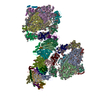
|
|---|---|
| 1 |
|
- Components
Components
-Photosystem I P700 chlorophyll a apoprotein ... , 2 types, 4 molecules AeBf
| #1: Protein | Mass: 83217.219 Da / Num. of mol.: 2 / Source method: isolated from a natural source Source: (natural)  References: UniProt: S4Z1K7, photosystem I #2: Protein | Mass: 82693.914 Da / Num. of mol.: 2 / Source method: isolated from a natural source Source: (natural)  References: UniProt: S4Z289, photosystem I |
|---|
-Protein , 4 types, 5 molecules CgOQZ
| #3: Protein | Mass: 8909.345 Da / Num. of mol.: 2 / Source method: isolated from a natural source Source: (natural)  References: UniProt: S4YZ47, photosystem I #19: Protein | | Mass: 56222.781 Da / Num. of mol.: 1 / Source method: isolated from a natural source Source: (natural)  References: UniProt: S4Z8N2, Translocases; Catalysing the translocation of protons; Linked to oxidoreductase reactions #21: Protein | | Mass: 87552.930 Da / Num. of mol.: 1 / Source method: isolated from a natural source Source: (natural)  References: UniProt: A0A7T7JN26 #30: Protein | | Mass: 5209.413 Da / Num. of mol.: 1 / Source method: isolated from a natural source Source: (natural)  |
|---|
-Photosystem I reaction center subunit ... , 8 types, 16 molecules DhEiFjHkIlJmKnLo
| #4: Protein | Mass: 21958.137 Da / Num. of mol.: 2 / Source method: isolated from a natural source Source: (natural)  References: UniProt: P36213 #5: Protein | Mass: 15476.541 Da / Num. of mol.: 2 / Source method: isolated from a natural source Source: (natural)  References: UniProt: P13194 #6: Protein | Mass: 24866.574 Da / Num. of mol.: 2 / Source method: isolated from a natural source Source: (natural)  References: UniProt: P13192 #7: Protein | Mass: 14900.113 Da / Num. of mol.: 2 / Source method: isolated from a natural source Source: (natural)  References: UniProt: P20143 #8: Protein/peptide | Mass: 4010.949 Da / Num. of mol.: 2 / Source method: isolated from a natural source Source: (natural)  References: UniProt: S4Z1D9 #9: Protein/peptide | Mass: 4747.620 Da / Num. of mol.: 2 / Source method: isolated from a natural source Source: (natural)  References: UniProt: S4Z1E9 #10: Protein | Mass: 13742.934 Da / Num. of mol.: 2 / Source method: isolated from a natural source Source: (natural)  References: UniProt: P36886 #11: Protein | Mass: 22229.730 Da / Num. of mol.: 2 / Source method: isolated from a natural source Source: (natural)  References: UniProt: P23993 |
|---|
-Chlorophyll a-b binding protein ... , 3 types, 4 molecules 1p5r
| #12: Protein | Mass: 26691.438 Da / Num. of mol.: 2 / Source method: isolated from a natural source Source: (natural)  References: UniProt: A0A287WC32 #15: Protein | | Mass: 27618.691 Da / Num. of mol.: 1 / Source method: isolated from a natural source Source: (natural)  #41: Protein | | Mass: 21976.850 Da / Num. of mol.: 1 / Source method: isolated from a natural source Source: (natural)  References: UniProt: Q9LKC7 |
|---|
-Chlorophyll a-b binding protein, ... , 3 types, 4 molecules 23qs
| #13: Protein | Mass: 27320.039 Da / Num. of mol.: 1 / Source method: isolated from a natural source Source: (natural)  References: UniProt: Q43485 | ||
|---|---|---|---|
| #14: Protein | Mass: 29374.547 Da / Num. of mol.: 2 / Source method: isolated from a natural source Source: (natural)  References: UniProt: F2DAN8 #42: Protein | | Mass: 23904.160 Da / Num. of mol.: 1 / Source method: isolated from a natural source Source: (natural)  References: UniProt: F2D0D5 |
-NAD(P)H-quinone oxidoreductase subunit ... , 12 types, 12 molecules GMNPRSTUVWXY
| #16: Protein | Mass: 38544.336 Da / Num. of mol.: 1 / Source method: isolated from a natural source Source: (natural)  References: UniProt: P92432, Translocases; Catalysing the translocation of protons; Linked to oxidoreductase reactions |
|---|---|
| #17: Protein | Mass: 53452.320 Da / Num. of mol.: 1 / Source method: isolated from a natural source Source: (natural)  References: UniProt: S4Z268, Translocases; Catalysing the translocation of protons; Linked to oxidoreductase reactions |
| #18: Protein | Mass: 13299.608 Da / Num. of mol.: 1 / Source method: isolated from a natural source Source: (natural)  References: UniProt: S4Z1L1, Translocases; Catalysing the translocation of protons; Linked to oxidoreductase reactions |
| #20: Protein | Mass: 11199.190 Da / Num. of mol.: 1 / Source method: isolated from a natural source Source: (natural)  References: UniProt: S4Z1I1, Translocases; Catalysing the translocation of protons; Linked to oxidoreductase reactions |
| #22: Protein | Mass: 19587.109 Da / Num. of mol.: 1 / Source method: isolated from a natural source Source: (natural)  References: UniProt: A0A4Y5SEJ9, Translocases; Catalysing the translocation of protons; Linked to oxidoreductase reactions |
| #23: Protein | Mass: 44563.441 Da / Num. of mol.: 1 / Source method: isolated from a natural source Source: (natural)  References: UniProt: S4Z272, Translocases; Catalysing the translocation of protons; Linked to oxidoreductase reactions |
| #24: Protein | Mass: 19271.131 Da / Num. of mol.: 1 / Source method: isolated from a natural source Source: (natural)  References: UniProt: A0A218LNN1, Translocases; Catalysing the translocation of protons; Linked to oxidoreductase reactions |
| #25: Protein | Mass: 18733.178 Da / Num. of mol.: 1 / Source method: isolated from a natural source Source: (natural)  References: UniProt: Q7GT16, Translocases; Catalysing the translocation of protons; Linked to oxidoreductase reactions |
| #26: Protein | Mass: 27568.764 Da / Num. of mol.: 1 / Source method: isolated from a natural source Source: (natural)  References: UniProt: S4Z232, Translocases; Catalysing the translocation of protons; Linked to oxidoreductase reactions |
| #27: Protein | Mass: 22240.281 Da / Num. of mol.: 1 / Source method: isolated from a natural source Source: (natural)  References: UniProt: F2CUR7 |
| #28: Protein | Mass: 24051.049 Da / Num. of mol.: 1 / Source method: isolated from a natural source Source: (natural)  References: UniProt: F2D138 |
| #29: Protein | Mass: 25928.014 Da / Num. of mol.: 1 / Source method: isolated from a natural source Source: (natural)  References: UniProt: A0A287M953 |
-Photosynthetic NDH subunit of subcomplex ... , 10 types, 10 molecules abc4d67890
| #31: Protein | Mass: 17835.777 Da / Num. of mol.: 1 / Source method: isolated from a natural source Source: (natural)  |
|---|---|
| #32: Protein | Mass: 23946.465 Da / Num. of mol.: 1 / Source method: isolated from a natural source Source: (natural)  References: UniProt: F2CTW7 |
| #33: Protein | Mass: 24733.996 Da / Num. of mol.: 1 / Source method: isolated from a natural source Source: (natural)  |
| #34: Protein | Mass: 13954.360 Da / Num. of mol.: 1 / Source method: isolated from a natural source Source: (natural)  |
| #35: Protein | Mass: 25818.414 Da / Num. of mol.: 1 / Source method: isolated from a natural source Source: (natural)  References: UniProt: F2CTD7 |
| #36: Protein | Mass: 51675.945 Da / Num. of mol.: 1 / Source method: isolated from a natural source Source: (natural)  References: UniProt: F2D3G1 |
| #37: Protein | Mass: 38079.977 Da / Num. of mol.: 1 / Source method: isolated from a natural source Source: (natural)  References: UniProt: F2D932 |
| #38: Protein | Mass: 13313.331 Da / Num. of mol.: 1 / Source method: isolated from a natural source Source: (natural)  References: UniProt: F2DD79 |
| #39: Protein | Mass: 9756.810 Da / Num. of mol.: 1 / Source method: isolated from a natural source Source: (natural)  |
| #40: Protein | Mass: 18146.125 Da / Num. of mol.: 1 / Source method: isolated from a natural source Source: (natural)  References: UniProt: F2DWH9 |
-Sugars , 1 types, 4 molecules 
| #49: Sugar | ChemComp-DGD / |
|---|
-Non-polymers , 11 types, 396 molecules 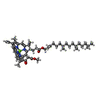

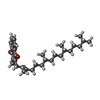




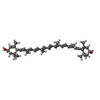
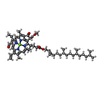
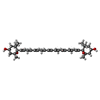











| #43: Chemical | | #44: Chemical | ChemComp-CLA / #45: Chemical | ChemComp-PQN / #46: Chemical | ChemComp-LHG / #47: Chemical | ChemComp-BCR / #48: Chemical | ChemComp-SF4 / #50: Chemical | ChemComp-LMG / #51: Chemical | ChemComp-LUT / ( #52: Chemical | ChemComp-CHL / #53: Chemical | ChemComp-XAT / ( #54: Chemical | |
|---|
-Details
| Has ligand of interest | N |
|---|---|
| Has protein modification | Y |
| Sequence details | UniProt database assigns these position to UNK. Author determined these residues. |
-Experimental details
-Experiment
| Experiment | Method: ELECTRON MICROSCOPY |
|---|---|
| EM experiment | Aggregation state: PARTICLE / 3D reconstruction method: single particle reconstruction |
- Sample preparation
Sample preparation
| Component | Name: PSI-NDH supercomplex of Barley / Type: COMPLEX / Entity ID: #1-#42 / Source: NATURAL |
|---|---|
| Source (natural) | Organism:  |
| Buffer solution | pH: 7.5 |
| Specimen | Embedding applied: NO / Shadowing applied: NO / Staining applied: NO / Vitrification applied: YES |
| Vitrification | Cryogen name: ETHANE / Humidity: 100 % |
- Electron microscopy imaging
Electron microscopy imaging
| Experimental equipment |  Model: Titan Krios / Image courtesy: FEI Company |
|---|---|
| Microscopy | Model: FEI TITAN KRIOS |
| Electron gun | Electron source:  FIELD EMISSION GUN / Accelerating voltage: 300 kV / Illumination mode: OTHER FIELD EMISSION GUN / Accelerating voltage: 300 kV / Illumination mode: OTHER |
| Electron lens | Mode: BRIGHT FIELD |
| Image recording | Electron dose: 50 e/Å2 / Detector mode: SUPER-RESOLUTION / Film or detector model: GATAN K2 SUMMIT (4k x 4k) |
- Processing
Processing
| CTF correction | Type: PHASE FLIPPING AND AMPLITUDE CORRECTION |
|---|---|
| 3D reconstruction | Resolution: 4.5 Å / Resolution method: FSC 0.143 CUT-OFF / Num. of particles: 103844 / Symmetry type: POINT |
 Movie
Movie Controller
Controller






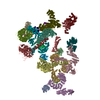

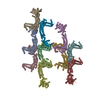
 PDBj
PDBj





























